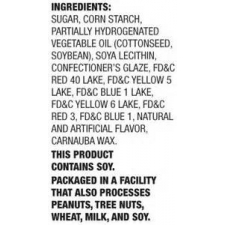Trans Fats Facts
The FDA (Food and Drug Administration) recently issued a statement saying that trans fats are “not generally recognized as safe” for use in human food. What this means is that trans fats, also referred to as partially hydrogenated oils, should not be part of our diets and will need to be eliminated from foods sold in the United States. According to U. S. regulators, trans fats will need to be removed from the food supply within the next 3 years. So what makes trans fats (partially hydrogenated oils) so bad. Below are some facts about why they are used, which foods typically contain them, and what these fats do to our bodies.
Trans fats are found naturally in some foods, but are mostly formed through an industrial process that adds hydrogen to vegetable oil (hydrogenation). This process causes the oil to become solid at room temperature. This manufactured form of trans fat is known as partially hydrogenated oil (PHO) and is the term you will see listed on the ingredient lists of foods that contain trans fats. The benefits of this type of fat in commercial use are that it is generally easy to use, inexpensive, and has a long shelf life. Partially hydrogenated oils can also be reused in commercial fryers and tend to give foods a desirable taste and texture that other healthier fats may not provide as effectively.
Foods that commonly contain trans fats include baked goods made with shortening, a form of partially hydrogenated oil, including pie crust, crackers, cakes, and cookies. Other examples of trans fat laden foods include ready-made frosting, chips, microwave popcorn, fried foods, and refrigerated dough (exs: frozen pizza crust, canned biscuits, and cinnamon rolls), non-dairy creamers, and stick margarine. The common factors all these foods share are that they are highly processed and loaded with fat and/or sugar. These are foods we already advise you to avoid because of their poor nutrition quality and ease in causing weight gain through their high empty calorie content. Also due to the desirable taste and texture that partially hydrogenated oils provide, foods that contain them become addictive when eaten regularly.
So what are these trans fats doing to our bodies when eaten? Not only are they loading us up with empty fat-forming calories, they are also increasing our risk of developing harmful medical conditions, such as heart disease. They do this by raising our low density lipoprotein (LDL) cholesterol, also known as our “bad” cholesterol, and lowering our high density lipoprotein (HDL) “good” cholesterol. LDL cholesterol functions by building up in our artery walls, causing our blood vessels to become hard and narrow, thus increasing our risk of heart attack and stroke. On the other hand, HDL cholesterol picks up the excess cholesterol and takes it back to your liver, preventing it from building up in your blood vessels. So essentially, trans fats are hardening and clogging our arteries by raising the “bad” and lowering the “good” cholesterols. Now you may see why these fats have been deemed unsafe for human consumption. By consuming a diet rich in lean proteins and high fiber, nutrient-dense vegetables and fruit (aka the Tristate Bariatrics Diet), you can essentially do the opposite of what trans fats do to the body, which is to raise the HDL and lower the LDL cholesterols.
Be sure to avoid any foods containing even small amounts of trans fat, which you will see listed on the nutrition facts label. Also, look at the ingredient list and avoid foods with “partially hydrogenated vegetable oil” listed as an ingredient.

GLAZED DONUT
Here is a nutrition facts label of a glazed doughnut that contains a whopping 4 grams of trans fat per serving.

Ingredient Label
Here is an ingredient list containing partially hydrogenated vegetable oil as its third ingredient. When reading an ingredients list, the item listed first is the one that is most prevalent, followed by the next, and so forth, with the last ingredient being the least prevalent.












